Flowers hold a significant position in our lives, civilizations, and traditions in addition to being aesthetically pleasing.
Every flower, from the colorful hibiscus to the sophisticated hyacinth, has a special tale to tell. We will look into the symbolism, significance, and meaning of the numerous flowers that begin with the letter H as well as how they have impacted art, literature, and human emotions throughout history.
This blog post on flowers that begin with H is sure to capture your attention, whether you are a flower connoisseur or you are just looking for ways to appreciate nature’s beauty.
Now let’s set out on this adventure together and explore the enchanted realm of flowers that begins with H.
Keep Reading:
- Flowers That Start With C
- Flowers That Start With D
- Flowers That Start With E
- Flowers That Start With F
- Flowers That Start With G
List Of Flowers That Start With H
1. Hypericum
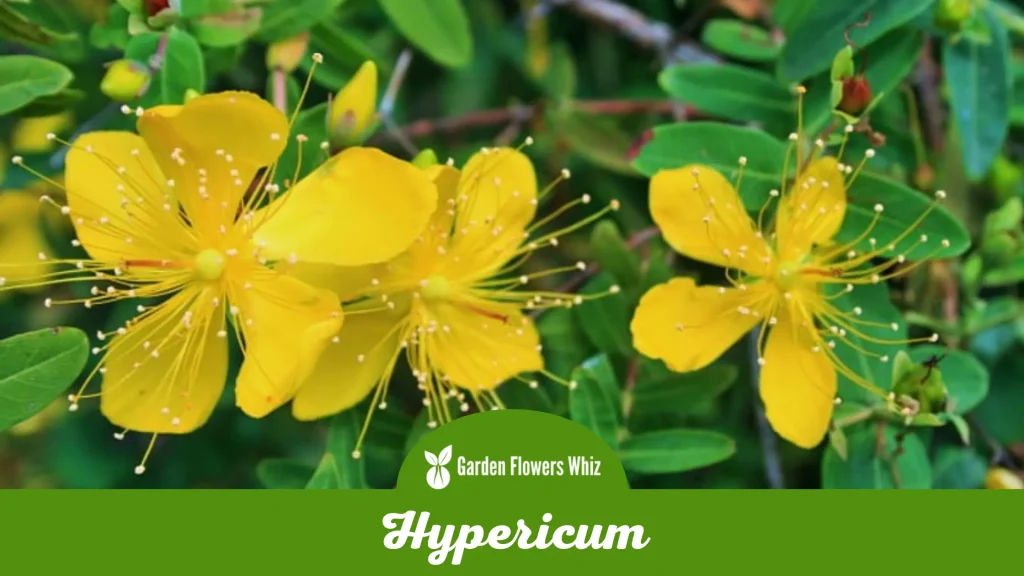
The flowering plant genus Hypericum, usually referred to as St. John’s Wort contains more than 400 species. These plants can bloom from late spring to early fall and are distinguished by their vibrant yellow flowers.
The flowers have a distinctive and lovely appearance since they are frequently star-shaped and have a large number of stamens. Europe, Asia, and North America are just a few of the locations in the world where hypericum is indigenous.
It is an adaptable plant that can grow in a range of soil types and lighting conditions, making it a great option for both inexperienced and seasoned gardeners. It requires relatively little maintenance.
2. Hydrangea

Over 70 different species of deciduous and evergreen shrubs belong to the flowering plant genus hydrangea. The plant is indigenous to Asia and the Americas and is distinguished by its big, beautiful blooms, which come in a variety of hues, including white, pink, blue, and purple.
Corymbs, which can occasionally measure up to a foot in diameter, is how the Hydrangea’s flowers are made.
In gardens, landscapes, and floral arrangements, hydrangeas are well-liked ornamental plants. Both inexperienced and seasoned gardeners favor them since they are generally simple to grow and can handle a variety of soil and lighting conditions.
Moreover, hydrangeas have many metaphorical meanings, such as thanksgiving, tenacity, and deep feelings.
3. Hybrid Tuberous Begonia
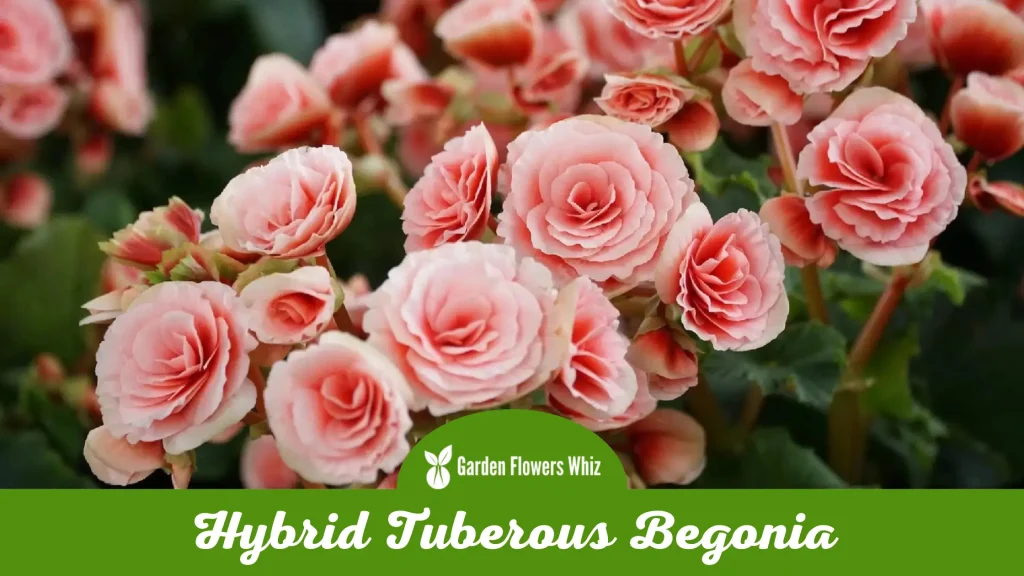
Popular garden plant Hybrid Tuberous Begonia is a native of South America’s tropical climates. It is renowned for its enormous, flamboyant blooms, which can be any hue from white and pink to red, orange, and yellow.
The petals of the blooms are normally double or semi-double and have ruffles, giving them a distinctive and lovely appearance. Hybrid Tuberous Begonia plants are comparatively simple to grow and can be multiplied by tuber division or seed.
A flexible plant, hybrid tuberous begonia, can be employed in a range of landscape settings. Further to being used as a cut flower in floral arrangements, it is excellent for borders, beds, and pots.
Mid-summer to early fall is when the plant blooms and both gardeners and flower enthusiasts love it for its eye-catching appearance and vivid hues.
4. Hyacinth
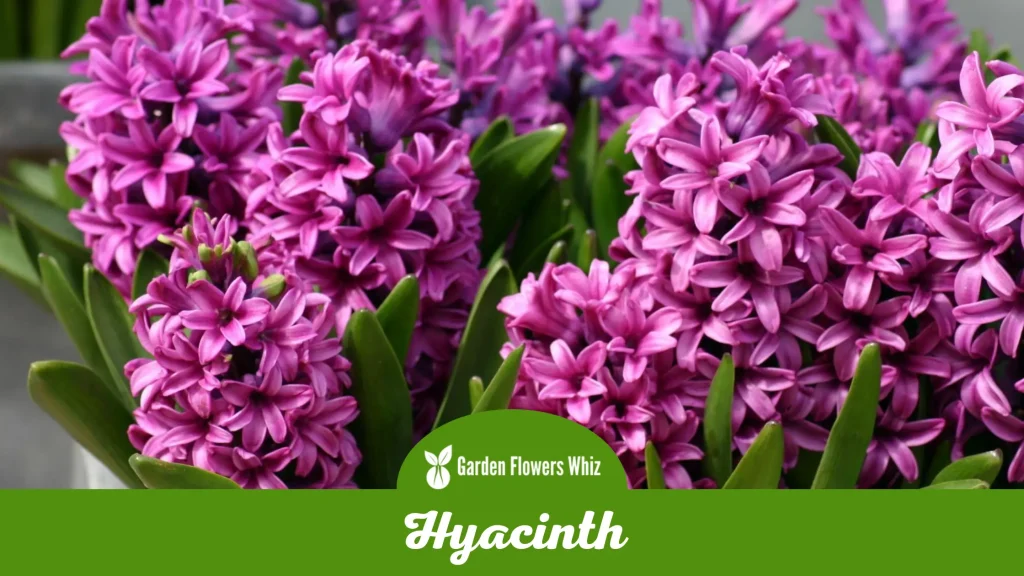
Bulbous plants called hyacinths are well-known for their colorful, fragrant blossoms. They are widely cultivated all over the world and have their origins in the eastern Mediterranean and western Asia.
Long, narrow leaves of hyacinths sprout from a bulb and develop upward in a tightly packed cluster. The flower spikes are covered in tiny bell-shaped blossoms that are often blue, pink, purple, or white and can reach heights of up to 12 inches.
Hyacinths are common ornamental plants used in both outdoor and indoor presentations. They occasionally serve as food and drink flavoring as well as being utilized in cosmetics and perfumes.
Hyacinths are known for their sweet and intoxicating aroma, which is supposed to be suggestive of springtime and fresh starts. Hyacinths are frequently presented as gifts to show admiration or devotion since they are commonly connected with rebirth, rejuvenation, and love in many cultures.
5. Hummingbird’s Mint
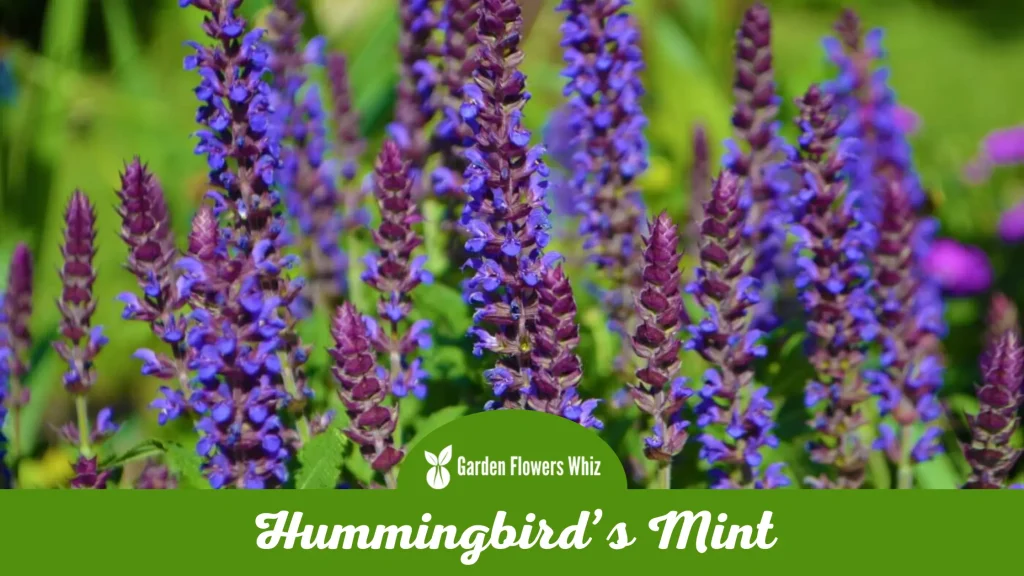
Bergamot, bee balm, and Oswego tea are other names for the North American native plant known as hummingbird’s mint. It is a perennial herb that blooms in mid to late summer in dazzling clusters of vivid pink, red, or purple flowers.
Hummingbirds, bees, and butterflies are drawn to the blossoms, which aid in pollinating the plant and dispersing its seeds.
Hummingbird’s mint has been used for both culinary and medicinal purposes for a very long time, in addition to its decorative significance. The plant’s leaves and blooms can be used to flavor food, prepare tea, scent soaps, and cosmetics, and they also have a potent, spicy aroma.
Hummingbird’s mint is a favorite among both gardeners and herb enthusiasts since it is simple to grow and tolerant of a variety of growth environments.
6. Hosta

Hosta is a stunning and adaptable perennial flower that is prized for both its eye-catching leaves and elegant blossoms. Hosta is a lily family plant that is native to East Asia. It is grown largely for its eye-catching leaves, which come in a variety of colors and patterns, including green, blue, and gold.
Often reaching heights of 18 to 30 inches, the plant thrives in moist, well-drained soil that receives partial to complete shade. Hosta produces gorgeous bell-shaped flowers, which range in color from white to lavender, in the summer on long stalks that protrude above the foliage.
Because they have a pleasant scent, the blossoms entice bees and butterflies to the garden. Hostas are a well-liked choice for both inexperienced and seasoned gardeners due to their ease of growth and maintenance.
Its foliage makes a magnificent statement in mixed containers, and they are frequently employed as ground covers or accent plants in borders.
It is no surprise that Hosta is a popular favorite among gardeners all over the world, given its beauty and simplicity of nurturing.
7. Horned Violet
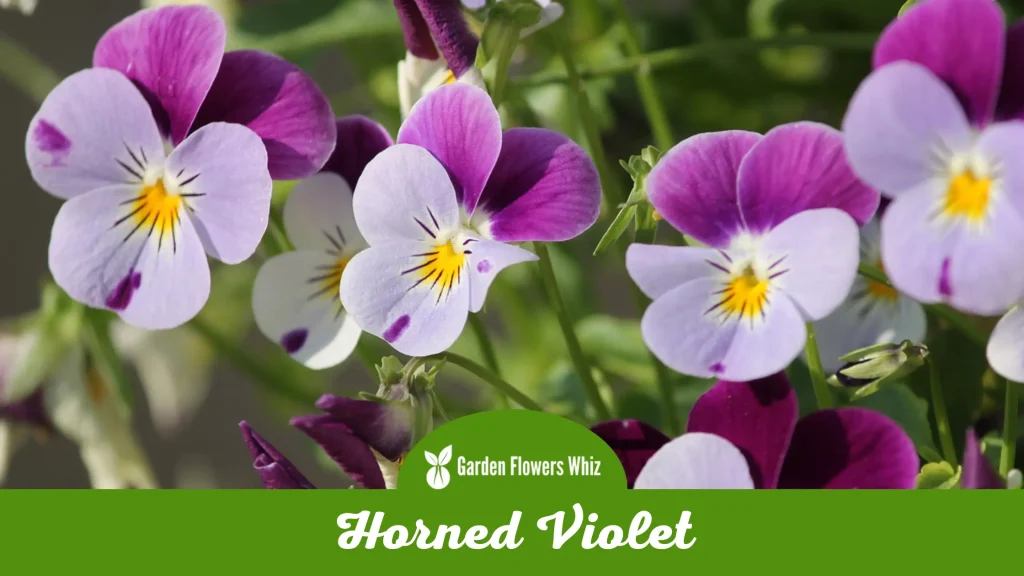
Viola cornuta, often known as the Horned Violet, is a pretty and distinctive flowering plant in the Violaceae family. The Pyrenees and the Alps in Europe are where this perennial plant originated, and it has subsequently naturalized in North America.
The distinctive horn-like protrusions on the lower petals of the Horned Violet give it its name. The plant extends out to a maximum of 12 inches and reaches a height of 6 to 10 inches.
It has heart-shaped, toothed, and hairy leaves that have a mounding habit. Early spring and summer bring out the Horned Violet’s delicate blossoms, which can be a variety of hues like purple, blue, pink, and white.
Also, they have a lovely scent that entices pollinators like bees and butterflies. Hardy in nature, the Horned Violet enjoys cool, wet soil and some shade.
It can be grown in rock gardens, borders, or containers and requires little maintenance. It is a common option for gardeners who wish to give their landscape a distinctive flair.
The Horned Violet is a lovely addition to any garden due to its distinctive appearance and lovely scent.
8. Hooker’s Orchid Cactus
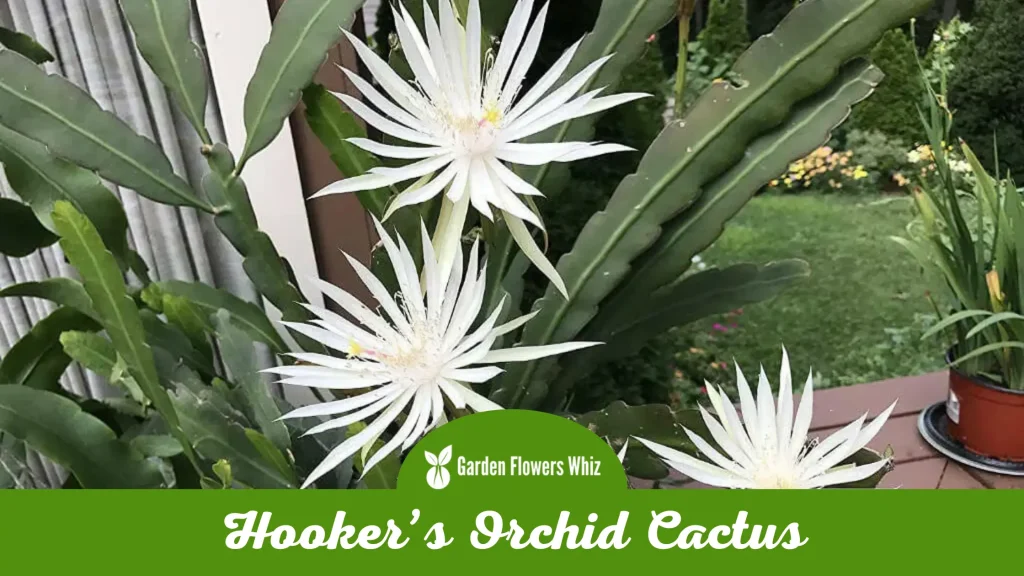
The magnificent epiphytic cactus known as Epiphyllum hookeri, or Hooker’s Orchid Cactus, is indigenous to Mexico and Central America. Its big, spectacular, orchid-like flowers, which can be up to 6 inches in diameter and bloom at night, are what give this exotic plant its name.
This flower is a favorite among gardeners because they are fragrant and appear in colors pink, red, orange, and white.
Since Hooker’s Orchid Cactus is an epiphyte, it can grow on trees and other buildings without endangering them. It features ten-foot-long, segmented stems that are long, flat, and have a leaf-like look.
The plant favors well-draining soil and indirect light that is bright. It can also withstand drought conditions and endure long stretches without water.
A stunning plant that is frequently grown indoors or in greenhouses is Hooker’s Orchid Cactus. Gardeners can give cuttings to friends and family, and it is extremely simple to propagate.
For those looking to add an exotic touch to their home or yard, Hooker’s Orchid Cactus is a well-liked option thanks to its distinctive appearance and fragrant blossoms.
9. Honeysuckle
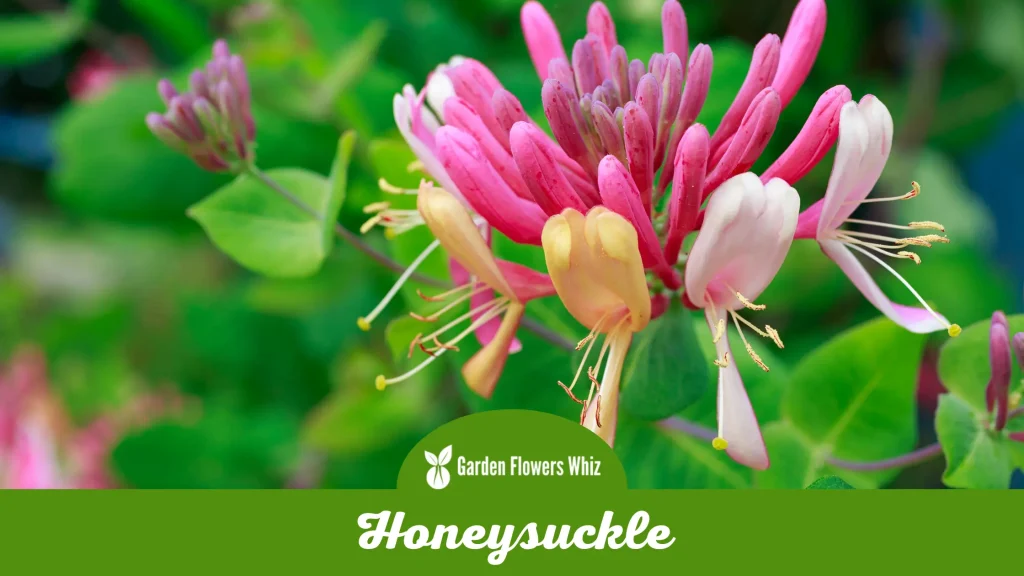
Gardeners all across the world like the lovely and aromatic climbing plant known as honeysuckle. The Caprifoliaceae family includes this deciduous or evergreen plant, which is indigenous to the Northern Hemisphere.
The plant produces clusters of tubular flowers that range in color from white to yellow, pink, and red and has long twining stems.
The fragrant blossoms draw hummingbirds and bees, two pollinators, to them. Honeysuckle is a well-liked option for gardeners who want to add height and interest to their landscapes because it is simple to grow and can be trained to climb walls, trellises, or fences.
It favors well-drained soil and full sun over partial shade. Although it benefits from routine watering, honeysuckle is also relatively low maintenance and can endure dry circumstances.
10. Honesty
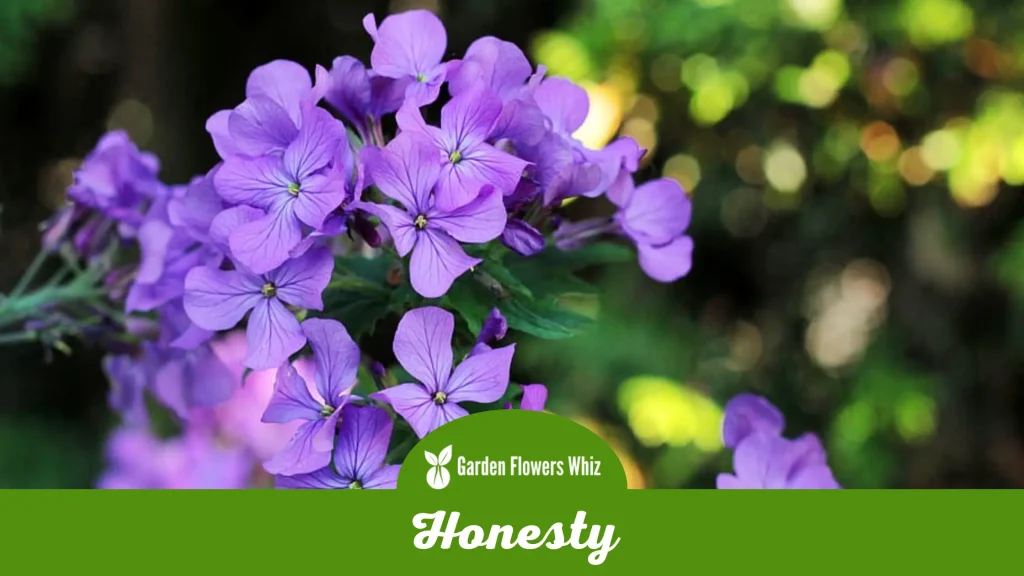
The biennial plant Honesty, also known as Lunaria, is a pretty and distinctive member of the Brassicaceae family. This plant has spread over the world despite being native to Southeast Europe and Western Asia.
The papery, rounded seedpods of honesty are unusual and frequently used in dried flower bouquets. The plant can reach a height of three feet and bears clusters of small, four-petaled blooms that bloom in white, pink, and purple hues.
Pollinators like bees and butterflies are drawn to the blooms, which are followed by seedpods, which begin as green and soon change into distinctive silver, translucent discs.
Though it may survive in a range of soil types and is simple to grow, honesty loves moist, well-drained soil in partial shade. It also requires only routine watering and generally little maintenance.
11. Hollyhock
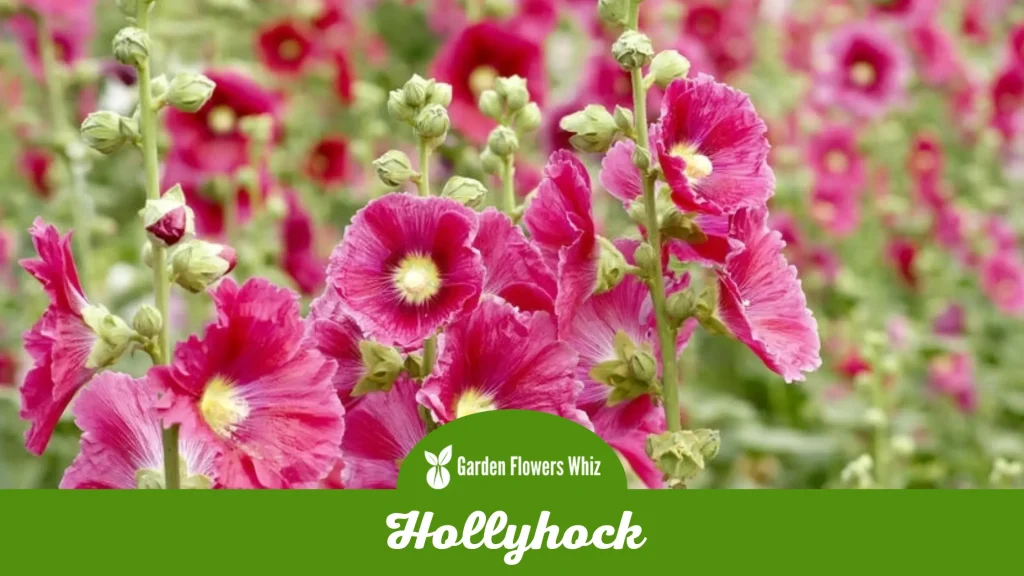
Alcea, another name for the tall and stout perennial plant known as the hollyhock, is a member of the mallow family. Despite being native to Asia and Europe, these flowers have been cultivated for generations in gardens all over the world.
The Hollyhock plant may reach heights of up to 8 feet and has a towering spike of voluminous, eye-catching blooms in hues of pink, red, white, yellow, and purple.
Hollyhocks are extremely simple to grow and like full light and soil that drains well. Its tall stature makes them a popular choice for backdrop planting or to add vertical interest to the landscape. They are common in cottage-style gardens.
Pollinators such as bees and butterflies also enjoy hollyhocks. They are used to treat a variety of illnesses and are said to have diuretic, laxative, and expectorant qualities. Hollyhocks are an elegant and timeless addition to any garden, in general.
They are a popular option for gardeners who want to add height and color to their landscape because of their spectacular blossoms and ease of growth.
12. Hollow Root
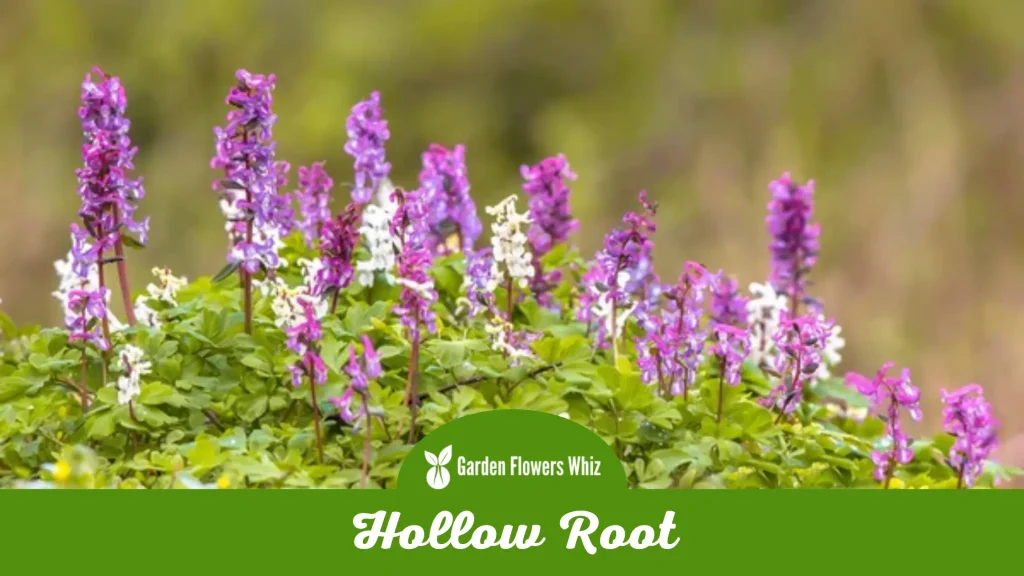
13. Highbush Blueberry

The Ericaceae family includes the deciduous shrub known as the Highbush Blueberry, also known by the scientific name Vaccinium corymbosum. It is indigenous to North America and is frequently discovered in forested, bog, and swampy environments.
The plant can grow up to 13 feet in height and produces clusters of tiny, white, or pink blooms in the spring. These blooms bloom throughout the summer, followed by delicious and healthy blueberries.
Highbush blueberries are prized for their delectable flavor and medicinal properties. They are frequently used in baking, cooking, and smoothies and are high in vitamins, minerals, antioxidants, and fiber.
Due to their appealing appearance and simplicity of maintenance, they are also a popular option for backyard gardeners. Highbush blueberries require regular watering and prefer acidic soil, full sun, or moderate shade.
They may be managed with the right care despite their susceptibility to some pests and diseases. Overall, the Highbush Blueberry is a very valued and sought-after plant because of the wonderful fruit it produces, in addition to its beauty.
14. High Mallow
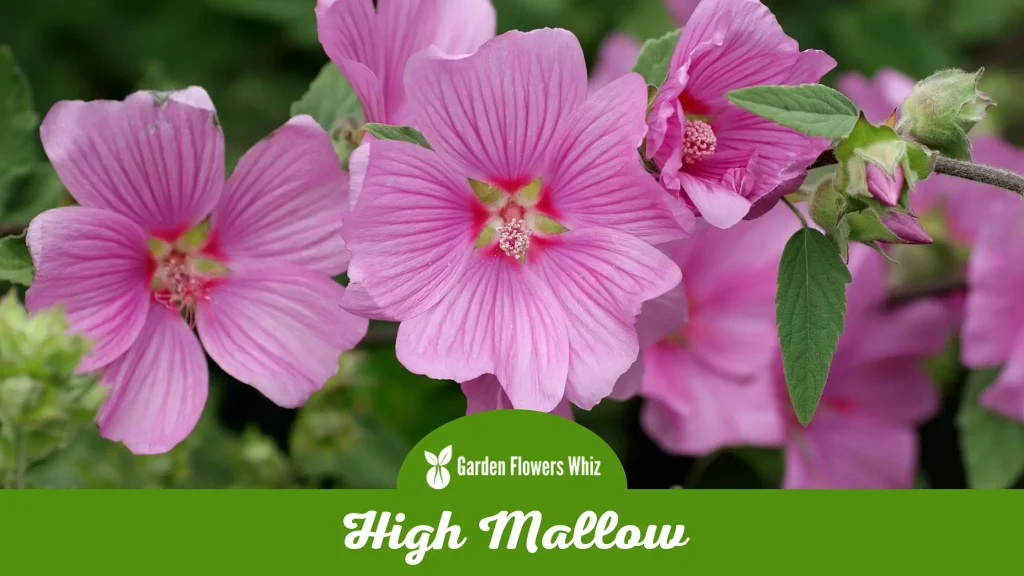
A perennial blooming plant belonging to the Malvaceae family, high mallow is often referred to as Malva sylvestris. Although it originated in Asia and Europe, it has since become a native in many other regions of the world.
The plant can reach a height of 4 feet and has spectacular, cup-shaped flowers in pink, purple, and white hues.
High Mallow is a simple-to-grow plant that is adaptable to a variety of growth environments. Although it may grow in poor soil and during periods of drought, it likes full sun to moderate shade and soil with good drainage.
Very well-liked for wildflower gardens, High Mallow attracts bees and other pollinators. High Mallow has long been used medicinally in addition to decorative uses.
It has been used to cure a variety of illnesses, including digestive disorders and respiratory problems, and is thought to have anti-inflammatory, antioxidant, and diuretic qualities.
It is a well-liked option for anyone wishing to add color and interest to their gardens because of its colorful blossoms and ease of growth.
15. Hibiscus
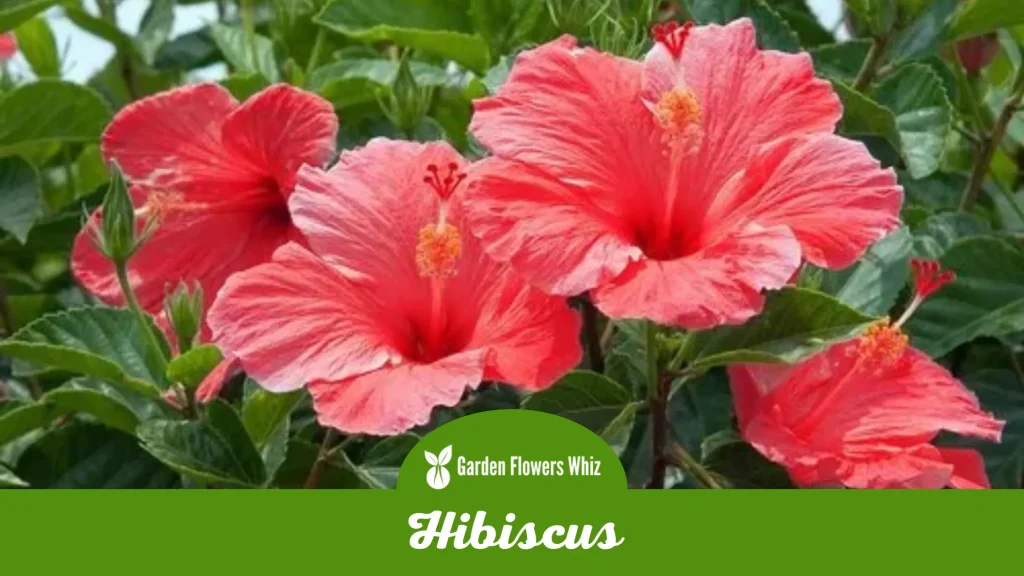
A tropical blooming plant known as hibiscus is a member of the Malvaceae family of plants. Asia, Africa, and the Americas are some of the locations in the world where it is indigenous that are warm temperate, subtropical, and tropical.
The plant is well-known for its big, spectacular flowers, which are available in a range of vivid hues, including red, pink, yellow, white, and purple.
In particular, in warm and tropical areas, hibiscus is a well-liked ornamental plant that is frequently utilized in landscaping and gardens.
It can be cultivated as a shrub or a small tree and prefers soil that drains well. The hibiscus plant produces stunning flowers that can be used in a variety of ways.
They can be used as a natural color as well as in teas, jams, and jellies. Hibiscus has long been utilized for medical purposes in addition to its beauty and culinary value.
It is thought to provide a number of health advantages, such as lowering blood pressure, reducing inflammation, and promoting weight loss.
It is a well-liked option for gardeners, chefs, and health enthusiasts alike because of its colorful and spectacular blossoms and variety of uses.
16. Hepatica

The Ranunculaceae family includes the little perennial wildflower hepatica, popularly known as liverwort. It is indigenous to the Northern Hemisphere and is widely distributed throughout the world’s temperate zones, including North America, Europe, and Asia.
Usually, only a few inches tall, the plant bears beautiful flowers in pink, purple, blue, and white hues.
Due to its resilience and appealing look, hepatica is a popular plant for rock and forest gardens. It thrives in regions with dappled sunshine because it prefers well-draining soil and light shade.
After a long winter, people wishing to add color to their gardens will find the flowers of the Hepatica plant to be the first wildflowers to bloom in the spring.
Hepatica is an attractive and resilient plant that brings a hint of early spring splendor to any garden or landscape. It is a well-liked option for both inexperienced and seasoned gardeners due to its delicate blossoms and simplicity of maintenance.
17. Hellebore

The perennial flowering plant known as hellebore, commonly referred to as the Christmas Rose, is a member of the Ranunculaceae family. The plant is a common decorative plant all over the world and is native to Europe and Asia.
Depending on the cultivar, the plant blooms with exquisite flowers in early spring or winter. The blossoms may offer a splash of color to a winter garden because they are available in a variety of hues, including white, pink, purple, and green.
Hellebore loves moist, well-draining soil and moderate to complete shade. The plant is a favorite among gardeners since it can grow in a variety of environments and requires little maintenance in general.
Given that its blossoms can survive up to several weeks in a vase, hellebore is also a well-liked selection for cutting gardens. Although hellebore is a lovely and resilient plant, it is crucial to remember that it is harmful if consumed.
The plant has cardiac glycosides and alkaloids that, if consumed, can result in symptoms like vomiting, diarrhea, and dizziness.
It is crucial to handle the plant carefully and keep it away from youngsters and pets as a result. All things considered, hellebore is a gorgeous and low-maintenance plant that brings a touch of winter splendor to any garden.
It is a well-liked option for both seasoned and inexperienced gardeners due to its exquisite blossoms and simplicity of maintenance.
18. Heliotrope

A native of Peru, heliotrope is a lovely and fragrant flowering plant. The plant, which is a member of the Boraginaceae family, is distinguished by its clusters of tiny, star-shaped flowers, which are available in purple, blue, and white hues.
The plant emits a sweet and distinctive aroma that has long been utilized in soaps and perfumes.
Because of its beautiful aroma and charming appearance, heliotrope is a favorite among gardeners. It can be grown in the ground or in containers and enjoys full light and soil with good drainage.
Depending on the kind, the Heliotrope plant’s flowers can bloom anywhere from late spring to fall and endure a long time.
It is a well-liked option for gardeners of all skill levels because of its exquisite blossoms and simplicity of maintenance.
19. Helenium
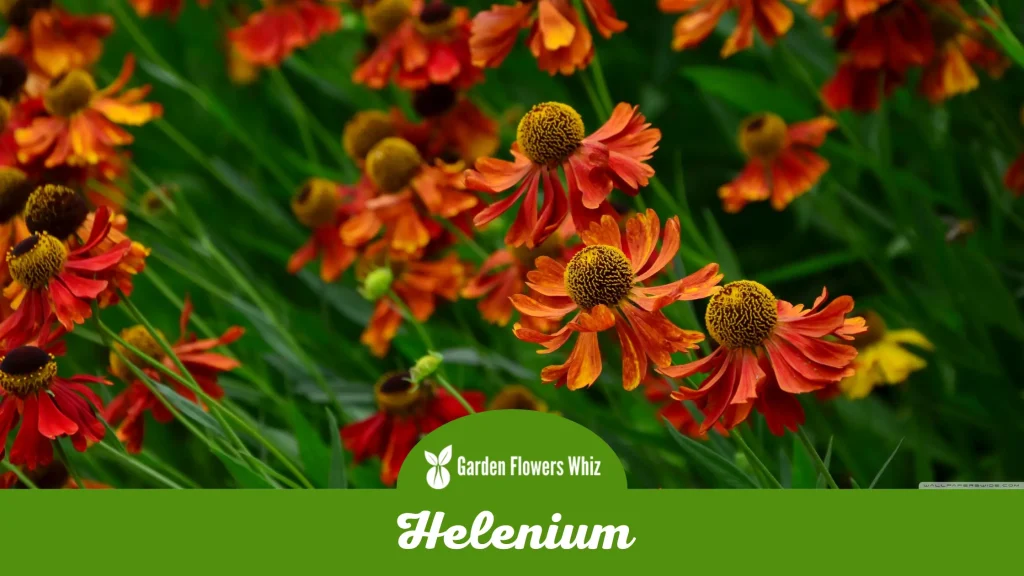
Asteraceae is a family of flowering plants that includes the genus Helenium. Because of its vivid and colorful blossoms, this plant, which is native to North and Central America, is a favorite among gardeners.
The Helenium plant’s flowers may provide a splash of color to any garden because they are available in a variety of hues, including yellow, orange, red, and bronze.
Hardy plants like helenium demand full sun and soil that drains well. It is a superb option for both beginning and seasoned gardeners because of its tolerance of a wide range of growing situations.
The flowering plant can be used as a cut flower and can be cultivated in beds or borders. Helenium is a common choice for luring pollinators to the garden in addition to its decorative appeal.
Bees and butterflies are particularly drawn to the plant’s nectar-rich blossoms. It is a popular selection for gardeners wishing to add a splash of color to their landscapes because of its vibrant and long-lasting blossoms and ease of care.
20. Hebe
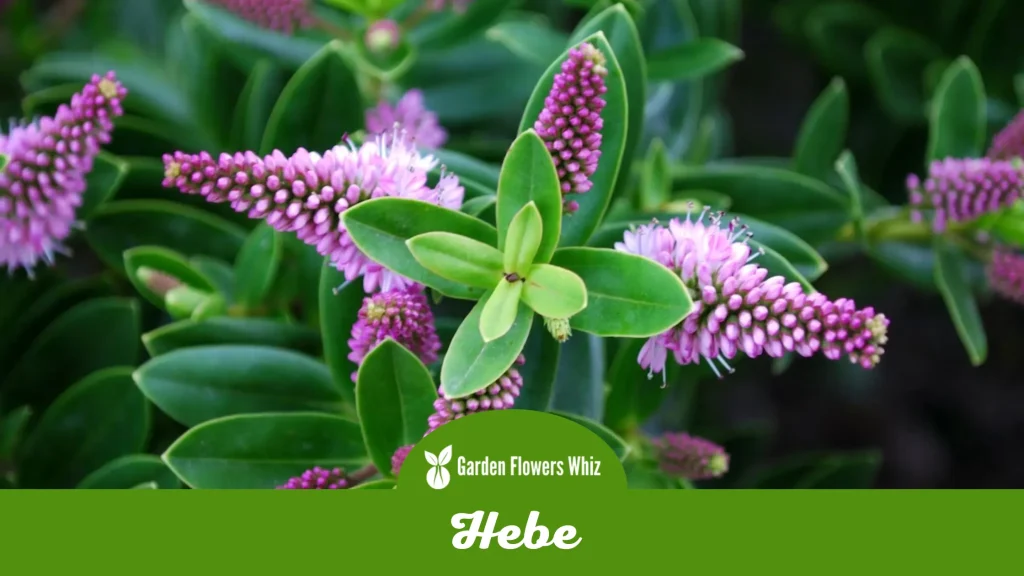
Hebe is a genus of evergreen shrubs of the Plantaginaceae family. The plant, which is native to New Zealand, is a favorite among gardeners because of its lovely flowers and elegant foliage.
Little, compact forms and enormous, tree-like specimens are only a few of the several sizes that the plant comes in. Little, leathery leaves of hebe plants are typically dark green, while some types have silvery or variegated leaves.
Depending on the kind, the blooms of the Hebe plant can bloom anywhere between late spring and early fall and come in a variety of hues, including pink, white, blue, and purple.
Hebe is a resilient plant that needs well-draining soil, full sun, or light shade. It is a superb option for both inexperienced and seasoned gardeners because it is tolerant of a wide range of growth situations and often requires little maintenance.
It is a well-liked option for gardeners wishing to add a touch of elegance to their landscapes because of its attractive blossoms and simplicity of maintenance.
21. Heavenly Bamboo
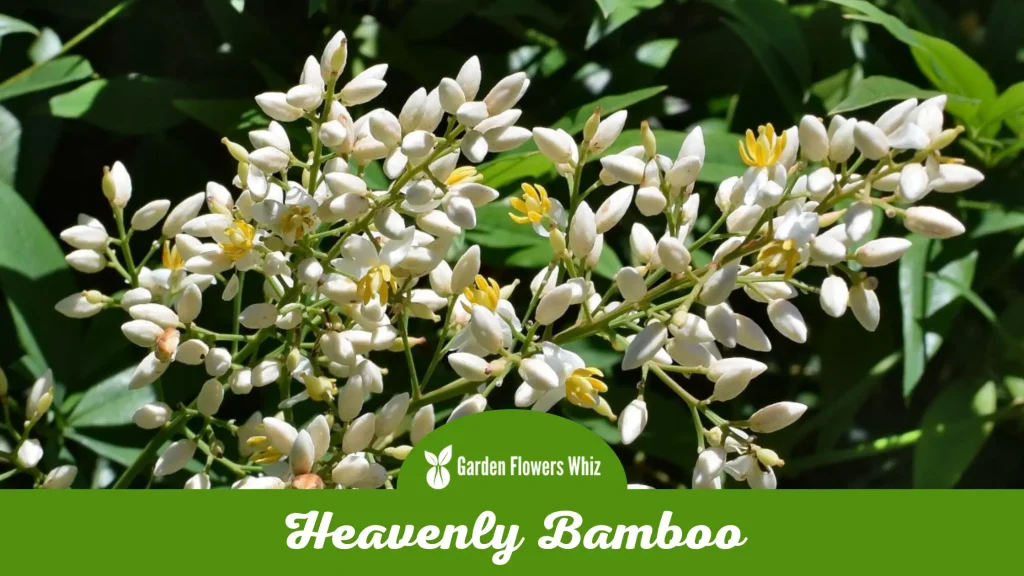
Eastern Asia is the home of the attractive evergreen shrub known as Heavenly Bamboo or Nandina. Despite its name, it is a member of the Berberidaceae family and not a real bamboo.
The plant is appreciated for both its clusters of tiny white flowers that bloom in the summer and its stunning foliage, which boasts brilliant green leaves that turn hues of crimson, purple, and bronze in the fall.
Hardy and low-maintenance, Heavenly Bamboo can reach heights and widths of up to 6 feet. Although it may thrive in a variety of environments, it likes full sun to moderate shade and well-draining soil.
The plant can be utilized as a border plant, hedge, or container plant in a number of garden situations. In addition to being beautiful, Heavenly Bamboo serves as a significant source of food for various animals, such as birds and butterflies.
Little red berries that the plant produces in the fall are appealing to a number of wildlife species. It is a popular option for gardeners wishing to add a touch of elegance to their landscapes because of its lovely leaf and simplicity of maintenance.
22. Heather

A flowering plant native to Europe and Asia is called “heather,” also known as Calluna vulgaris. A member of the heath family, the plant is a favorite among gardeners for its lovely flowers and elegant foliage.
Typically, hedging plants have tiny, needle-like leaves that are evergreen and come in a variety of colors, from dark green to grey or silver.
The plant’s blossoms bloom in a variety of hues from late summer to early October, including pink, purple, and white.
Hardy and prefers full sun and soil with good drainage; hedging is a plant. It is a great option for both inexperienced and seasoned gardeners because it tolerates a wide range of growth circumstances, including dry weather and poor soil, and it normally requires little maintenance.
It is a well-liked option for gardeners wishing to add a dash of elegance to their landscapes because of its vibrant blossoms and simplicity of maintenance.
23. Hardy Hibiscus
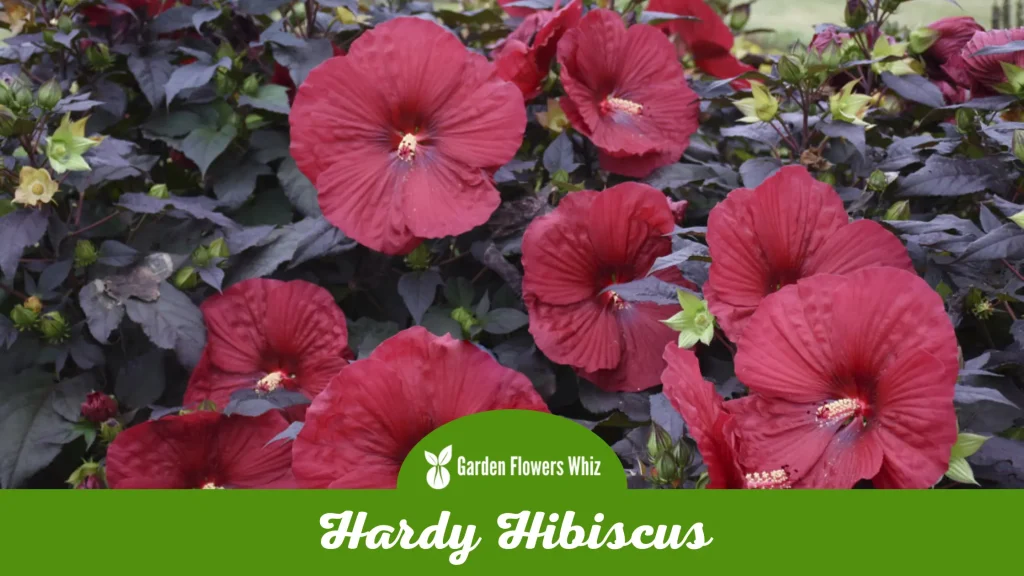
The perennial flowering plant known as Hardy Hibiscus, often referred to as Hibiscus moscheutos or Rose Mallow, is indigenous to the eastern United States.
The Tough Hibiscus can resist low temperatures and thrive in a variety of growing circumstances, in contrast to its tropical sibling.
Large, spectacular flowers in hues of pink, red, white, and lavender are produced by the plant from midsummer to fall, and it normally reaches heights and widths of up to 6 feet.
A resilient and low-maintenance plant, hibiscus enjoys full light and soil that drains well. It may thrive in a variety of growth environments, including dry weather and poor soil, and it can even grow in wet or muddy soil.
The plant is frequently used in gardens as a specimen plant, border plant, or the center of attention in a mixed border.
The plant serves as a significant source of nectar for hummingbirds and butterflies. It is a well-liked option for gardeners wishing to add a bit of elegance to their landscapes because of its big, vibrant blossoms and simplicity of care.
In Summary
The universe of flowers that starts with H is enormous and varied. From the hyacinth’s delicate beauty to the hibiscus’ dazzling vibrancy, these flowers provide a variety of meanings and symbols that can enthrall and inspire us.
Let’s not overlook the enchantment and wonder of these lovely flowers that begin with the letter H as we continue to discover and enjoy the delights of the natural world.
They can serve as a reminder to take time to calm down and appreciate the beauty that is all around us, whether they are blossoming in your gardens or on display in a vase.

Stacey Hernandez is a seasoned botanist with over 16 years of experience in the field. Her passion for plants and their intricate workings began at a young age, and she has since devoted her life to studying and understanding them.
Stacey’s expertise extends to a wide range of plant species, from delicate flowers to towering trees. As the founder of Garden Flowers Whiz, Stacey has created a platform for plant enthusiasts to seek guidance and advice.
Her website is a go-to resource for those seeking answers to their gardening dilemmas, whether it’s how to care for a particular plant or which species to choose for a specific climate.
